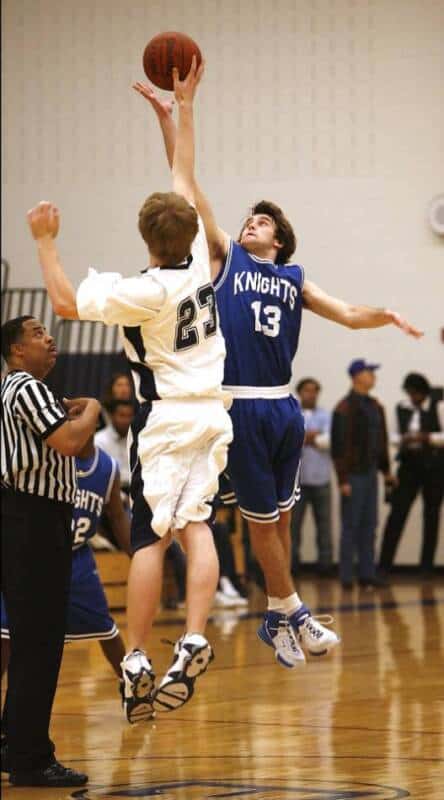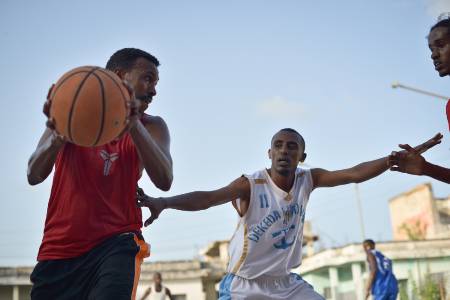
Basketball is a game that has evolved a ton since it was first invented in the late 1800s by James Naismith. Basketball started with only 13 basic rules that players had to follow, but over time it grew to have dozens if not hundreds of them.
Some of them get called 10 times in a single game, while others only get called once a season. One of the more commonly called fouls in basketball is hand checking.
But what is hand checking in basketball?
Hand checking is when a defensive player uses their hands or arms to impede or stop a player that has the ball. There are a few caveats when it comes to hand checking, but it’s generally called anytime a defender places both hands on an offensive player and impedes their path.
While that’s a general overview, we’ll go into more detail about hand checking, how it’s called, and what the penalty for the foul is throughout this article.
What Is Hand Checking in Basketball?
Hand checking is when a defensive player impedes the movement of an offensive player using both of their hands. It’s often called when an offensive player has the ball, but it can also be called against players off the ball.
Here are a few clear cases where hand checking would be called a foul:
- A defensive player uses their hands or arms on an opponent to control or alter their movements.
- A defensive player uses their hands or arms to restrict the movements of an opponent in any way.
- A defensive player uses their hands or arms to change the direction that an opponent is running or moving.
In each of these cases, a hand checking foul would be called, and a personal foul would be assessed to the guilty party.
Hand checking has been around for decades, but it didn’t start getting called regularly until the 2004-2005 NBA season. It trickled down to the college and high school levels from there, and hand checking now gets called at all of these levels of competition.
The hand checking foul is somewhat similar to a reach-in foul, and it’s easy to confuse the two if you’re not familiar with them. A reach-in foul is when a defensive player “reaches in” to steal the ball from an offensive player and makes excessive contact with them.
It’s usually the result of the defender slapping, grabbing, or pushing the offensive player’s arm or hand. Unlike the hand checking foul, which requires both hands to be placed on the offensive player, a reach-in foul only needs one hand of the defender to make contact.
Is Hand Checking a Penalty in the NCAA?
Hand checking in the NCAA is a penalty, but it’s undergone more changes and controversy than in the NBA. Before the start of the 2013 NCAA basketball season, they changed the hand checking rule to be a hands-off rule.
Any time that a defender placed both hands on an offensive player, a foul was called. The change was made in the hopes that it would increase the offensive output of games.
Unfortunately, it led to longer games with more fouls and free throws, but teams have adapted, and the hands-off hand checking rule is now just another part of the game. To this day, hand checking is still a penalty in the NCAA and will be for the foreseeable future.
Why Did the Hand Checking Rule Get Changed in College?
Since its inception, college basketball had been mostly a defensive game, with many games having total scores under 100 points. To make games more entertaining for the masses, the hand check rule was put into place with the hopes of creating higher-scoring games.
When players were first getting used to the hand check rule change, it often led to longer, slower games with frequent stoppages and free throws.
As teams have adapted to not being allowed to place more than one hand on a player, fewer fouls have been called and games are higher scoring. The hands-off rule change has opened up the game more for offensive players and has given them more space to operate.
As with most things, players learn to adapt and change their style of play on defense to accommodate a hand check rule change.
Is Hand Checking a Penalty in High School Basketball?

Hand checking is a penalty in high school basketball, but it’s called differently than it is in the NCAA and the NBA. Because high school basketball is played differently in different areas of the country, many areas have their own rules. In general, however, here is how the hand check rule is called at the high school level.
- Hand checking will be called if the defender leaves his hand on an opponent for too long.
- Hand checking will be called if the defender repeatedly places his hand on an offensive player.
- Hand checking will be called if the defender places both hands-on the offensive player.
- Hand checking will be called if the defender repeatedly jabs at the offensive player, making contact with them instead of the ball.
- Hand checking will be called if the defender performs an illegal armbar against an opponent.
Just looking at the rules, it would appear that hand checking is called more often at the high school level than at the college or NBA level. This often isn’t the reality, however, because every game is officiated differently.
High school officials also don’t have the same amount of training that officials at other levels do, which means that hand check rule changes don’t always get enforced.
In general, hand checking is still a penalty in high school basketball, but it doesn’t get called enough in most games to alter the flow of the game.
Why Is Hand Checking a Penalty?
Hand checking is a penalty in basketball because modern basketball wants to emphasize the game being less physical. In past years, defenders were allowed to put one or more hands on an offensive player and greatly restrict the offensive player’s movement.
Basketball has evolved, however, and players are bigger and stronger than they used to be, which increases the risk of injury with too much physicality. The hand checking penalty also makes basketball more fun to watch in that more points are scored per game because defenders have to be more passive and less physical.
The rule started with a few hiccups when players were getting used to it, and games were slow with lots of stoppages as a result. As defenders have adapted, however, games now go off without a hitch and the hand checking penalty gets called much less frequently than it used to.
Penalty for Hand Checking
Hand checking is a personal foul and carries the same penalty as any other personal foul. When a player is called for hand checking, they are assessed a personal foul.
In the NBA, players are allowed to commit six personal fouls before they are automatically disqualified. In the NCAA and high school, players can commit five personal fouls before automatic disqualification.
Hand checking is usually called when an offensive player is dribbling the ball, but it can also occur as the player is taking a shot. If this happens, the defensive player is assessed a personal foul and the offensive player is rewarded with two free throws. Hand checking fouls also count as team fouls when committed on the defensive end.
NBA Hand Checking Rule

The NBA hand checking rule is the same as the NCAA rule in how it’s called. Anytime a defensive player uses both of their hands to slow, divert, or impede an offensive player’s movement, hand checking is called.
The NBA has felt a more profound impact on the way the game is played than at any other level because of the types of players in the NBA.
Professional basketball started as a non-physical game of finesse and style. Over the years as players started working out more and getting bigger and faster in general, the game became more physical. It got so physical to the point that most NBA games were decided in low-scoring affairs with teams rarely scoring over 90 points.
Nowadays, it’s uncommon to see teams score fewer than 100 points whether they win or lose. The increase in scoring is due in part to players shooting many more 3-pointers than they used to but the rule has also had an effect.
Because defensive players have to play less physically than they used to, offensive players have more freedom and room to roam with the ball. The result is that there’s a lot more scoring than there used to be.
When Did Hand Checking Become a Penalty in the NBA?
Hand checking has always been a penalty in the NBA, but it’s undergone a few rule changes since its original inception. In 1994, the NBA started enforcing hand checking more than in years past, but nothing too extreme. The real change in hand checking came in 2004 when referees really started enforcing it as a penalty.
Up to that point in 2004, hand checking was just another foul that only got called in extreme situations when excessive physical force was used. That all changed, however, when players were no longer allowed to hand check in any way shape or form. It took a while for players to get used to the more stringent hand checking rule, but once they did, it just became another part of the game.
Players are now taught growing up in basketball not to hand check. It’s being instilled in their minds at a young age so, by the time they reach the high school or college level, hand checking isn’t an issue anymore.
Hand checking in the NBA came at a time when basketball fans were starting to lose interest in defensive-minded basketball games and wanted to see more scoring. The rule was instigated to increase the excitement level of games, but it also helps to limit injuries due to physical play.
Defensive players are less likely to place their hands on offensive players as they’re driving into the lane and the result is that fewer players are getting hurt.
How Do Referees Call Hand Checking?
Referees call hand checking fouls by signaling with their hands and shouting to the scorer’s table about who committed the foul. The signal that they use is similar to the signal that football referees use for illegal contact penalties.
The referee will blow their whistle to stop play. They will then extend one of their hands in front of their chest while simultaneously grabbing the extended wrist with the opposite hand. The referee will then say hand checking and specify the number of the guilty player and the color of their jersey.
Related Posts
- What Is a Backcourt Violation in Basketball? A Rules Guide
- Charging in Basketball: A Complete Guide to How It’s Called
- What Is a Clear Path Foul in Basketball? A Complete Overview
- What Is a Loose Ball Foul in Basketball? Rules and Penalties
- How Much Do NBA Coaches Make? A Complete Salary Overview
- How Much Do NBA Refs Make? A Salary Guide for Referees
- What Is a Technical Foul in Basketball? A Complete Overview
